I can still feel that bittersweet pang of enthusiasm and disappointment when Toyota announced the GR Yaris — that homologation-special, all-wheel-drive three-door hatchback that seemed to deliver everything a rally fan could ever want in a daily driver. I was disappointed, because I knew we’d never get it in the United States. But Toyota promised something for us. We’d just have to wait.
So we waited and waited, and waited some more. We waited so long that, back in August 2021 when I got my first chance to drive the GR86, a Toyota engineer offered me a glimpse at a photo of a GR Corolla prototype. The reveal couldn’t be more than a month or two away, the engineer reasoned.
It proved to be much further away than that, and now we know why. It was around that time that Chief Engineer Naoyuki Sakamoto was given an edict by none other than Toyota CEO Akio Toyoda: “Make it wider and wilder,” the executive and moonlighting race-car driver told him.
So Sakamoto’s team did, and so it is. The crew managed to extract even more horsepower out of that turbocharged, 1.6-liter G16E-GTS three-cylinder — 43 hp better than what the Yaris offers, for a nice round total of 300 hp. This was the greatest challenge of the GR Corolla’s development, Sakamoto-san told me as he snapped smartphone photos of grinning journalists getting out of the track-ready Morizo Edition. His smile matched theirs; he seemed proud of his work. He has every reason to be: The GR Corolla is magnificent.
Full disclosure: Toyota flew me all the way from Pennsylvania to Utah and put me in a hotel for two nights in Park City just to drive the GR Corolla and manual-transmission Supra.
What Is the Toyota GR Corolla?
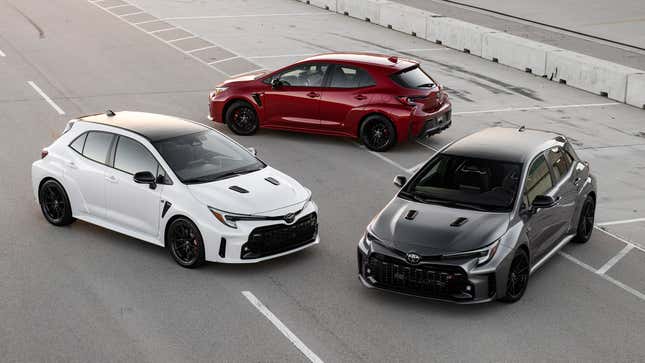
The GR Corolla is many things. It’s the spiritual successor to the Celica GT-Four that brings Sega Rally kids like myself to our knees. It’s also the likely recipient of all of Subaru’s would-be WRX STI sales, now that Subaru has given up on the STI for reasons the world’s greatest minds will never understand.
First and foremost though, the GR Corolla is a 300-horsepower, all-wheel-drive, five-door hatchback derived from the smaller GR Yaris — which itself was born out of Toyota’s World Rally Championship program. The GR Corolla starts at $36,995 including destination. Performance upgrades, like front and rear limited-slip differentials and larger brakes, as well as upgraded interior amenities, are available through optional packages. The $42,000 Circuit Edition gives you all that and throws in suede seats and more aggressive exterior trim. Check out my GR Corolla pricing post for a deeper breakdown on the dollars-and-cents front.
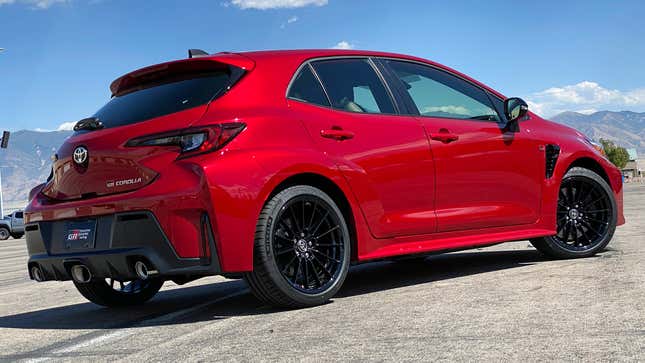
I won’t focus too much on styling because we’ve all seen the pictures by now, but I love the GR Corolla’s exterior, particularly in Supersonic Red. The effort to maker the GR Corolla “wider and wilder” didn’t end in comedy as it often does with many performance compacts — the dramatic haunches express a clear purpose, while little touches like the “GR-FOUR” tattoo on the Circuit Edition’s intercooler reward a perceptive eye.
How Does it Drive?
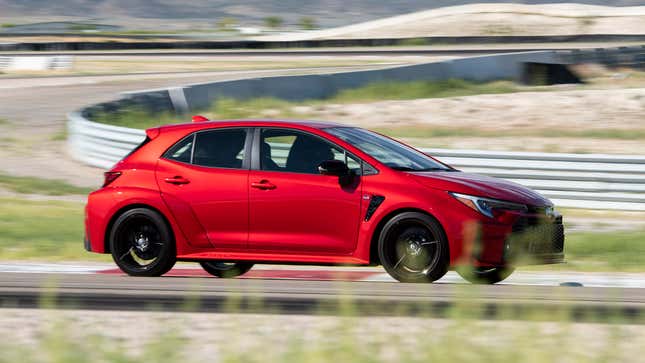
The venue Toyota chose for the media’s first one-on-one meeting with the GR Corolla was Utah Motorsports Campus — a track probably more well known under its old moniker, Miller Motorsports Park. For this event, Toyota divided UMC into two circuits: a tighter, more technical East Course where we got to grips with the Corolla, and a faster, more power-dependent West Course that we used for the Supra.
The East Course was the right choice for the GR Corolla, and that says something because the Supra is no slouch. Rallying roots aside, this is a hot hatch that feels sharp enough to claim the track as its second home. I felt assured of that in the first set of corners — a sequence of high-speed, gentle esses guaranteed to elicit body roll in a machine that isn’t dialed in for the task. The Corolla remained poised, through and through.
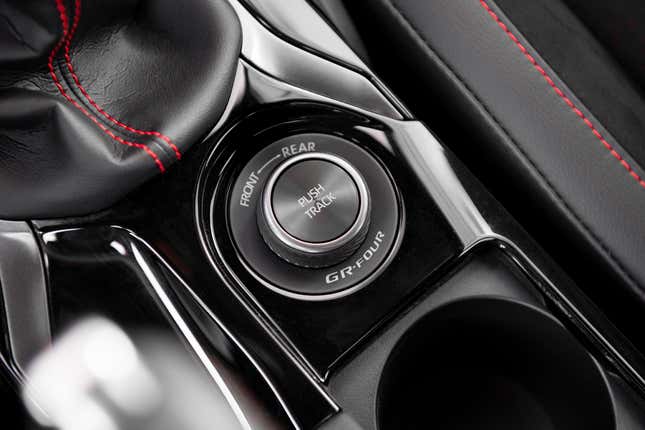
Part of that was down to the torque split of the GR Four all-wheel drive system. With the twist of a dial located aft of the shifter, you can adjust the Corolla’s power delivery. The default setting sends 60 percent of torque to the front axle; turn the knob to “Rear” and you get a 30/70 front-rear split. Push the “Track” button in the middle and you get an even 50/50.
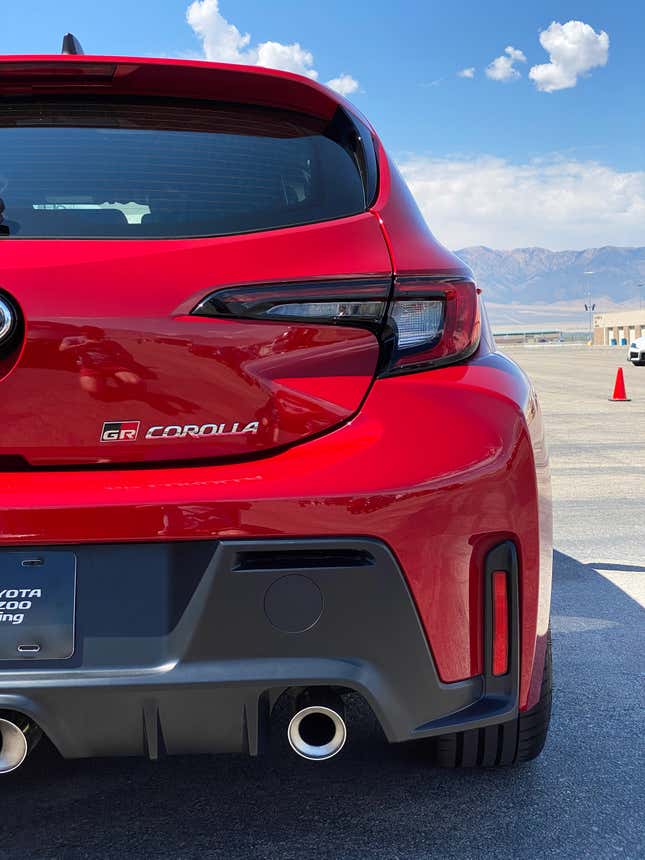
The effects are predictable. The front-biased default mode, which Toyota considers optimal for everyday driving, is a recipe for understeer. The rear-biased setting obviously isn’t the best choice for those seeking fast laps, but there’s more to life than numbers. I could see myself leaving it in 50/50 most of time, where the Corolla just never wants to let go — particularly if you have the benefit of those Torsen limited-slip differentials, standard on the Circuit Edition or available with the Performance Pack on the Core model. For everyday commuting, the LSDs aren’t strictly necessary. But those planning to track, or those concerned about maximizing grip in slippery conditions won’t want to leave that performance on the table.
I had the privilege of sampling all three grades of the GR Corolla, including the ultra-limited Morizo Edition. The powertrain is the constant between them all, though the Morizo receives a slight boost in torque — 295 lb-ft versus 273 lb-ft on the standard models — as well as a close-ratio six-speed for improved acceleration.
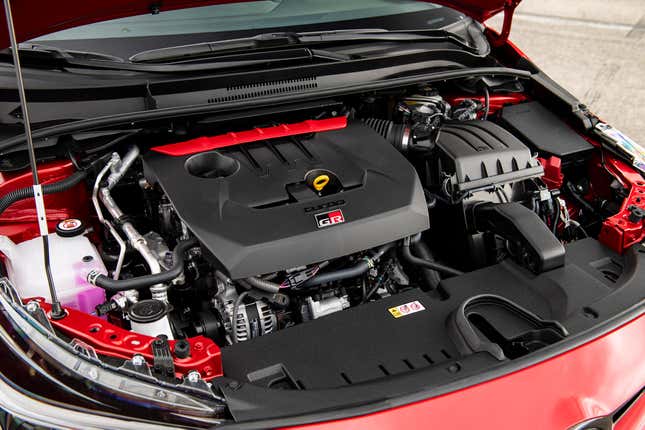
The GR Corolla’s 300 hp and 273 lb-ft feel perfectly suited to the car. It certainly doesn’t need more power, though I’m sure the chronically unsated will pine for it, just as they still do with the second-gen Toyobaru. The Aisin-sourced six-speed manual feels great — notching it into gear strikes that satisfying balance between precision and heft, with a just-right degree of progressive resistance. Starting off from a stop is a little more finicky than in the manual Supra with its gobs of torque, but that’s to be expected. Third gear might be a smidge too tall on those non-Morizo models, but then again UMC’s East Course is heavy on third in this car.
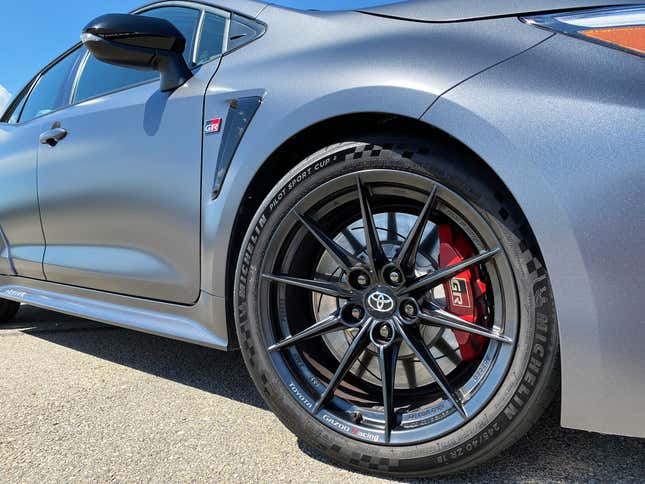
As for that Morizo? It’s a dream. But then how could it not be, given the deleted back seat, extra bracing and weld points, stickier Pilot Sport Cup 2 rubber (compared with the Pilot Sport 4 on Core and Circuit variants) and aforementioned torque and gearbox optimizations. The Morizo shaves off more than 100 pounds compared to the 3,252-pound Core, and the upshot of every nip and tuck was total bliss on the desert tarmac. No notes. I have a fondness for hatchbacks so hell-bent on performance that they absolutely crater the practicality everyone expects from them (looking at you, Clio V6). I’m baffled and delighted that Toyota, of all brands, is selling a vehicle so singularly focused — even if only a lucky few will bring them home.
How’s the Interior?
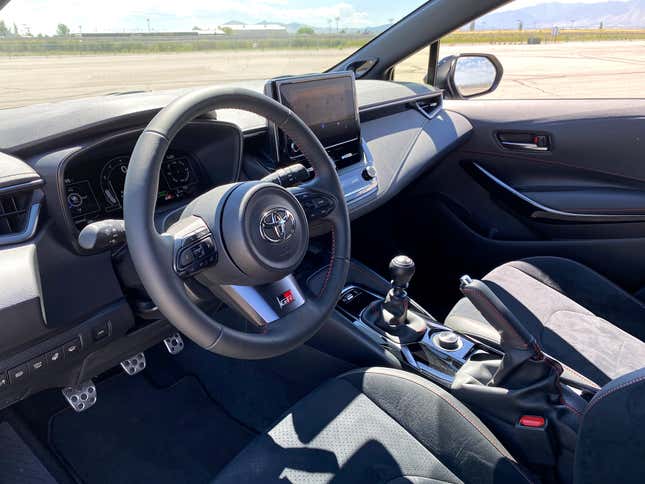
There isn’t all that much separating the GR Corolla’s interior from that of a regular Corolla hatch, and I actually find that to be a relief. Strip out the drivetrain and this really is an economy car, built by the automaker that literally invented the modern method of assembling cars. The materials aren’t dazzling and the interior design is hardly stirring, but that blandness offers its own comfort, because Toyota clearly focused on the important stuff.
After spending a week with the Volkswagen Golf R recently, I entered the GR Corolla’s cabin overjoyed for my fingers to meet physical buttons and knobs controlling pretty much everything — yes, even the climate stuff. The current-gen Corolla employs the new Toyota Multimedia System interface that debuted in the 2022 Tundra. As my friend José discovered last year, it might just be the simplest infotainment software in the industry today.
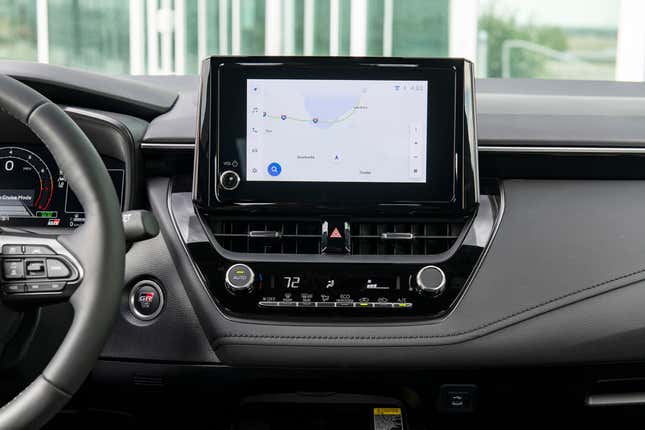
There’s a column of five categories on the left, tied to clear, obvious icons — navigation, media, phone, vehicle and settings. Each contains straightforward menu options, laid out in a monochrome interface with easy-to-read fonts. Remarkably, there isn’t a whole lot you can do with this system, and that’s shocking, and frankly delightful, to be able to say about an automaker’s in-dash software in 2022.
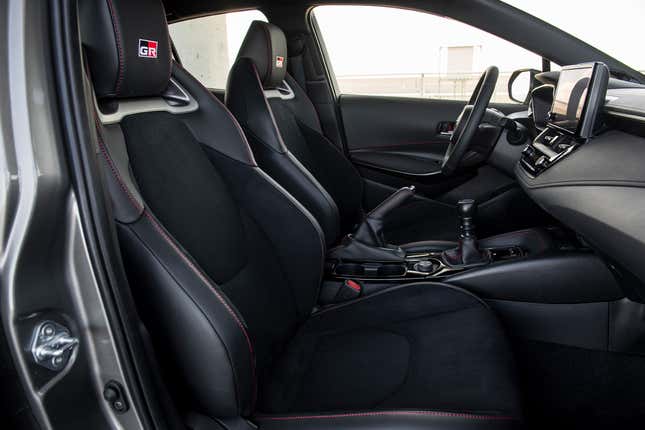
The front seats in both the Core and Circuit editions are comfortable enough and well-bolstered, but the latter’s win because they’re lined in perforated suede. Here’s hoping that becomes an option on lower models after the 2023 model year — right now, suede isn’t available on the Core, even if you opt for the cold weather or tech packages.
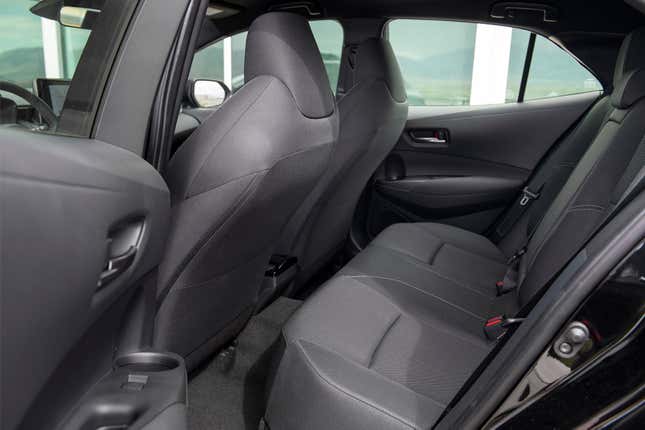
In fact, Toyota might’ve gone a little too far with the cost-cutting on the bargain GR Corollas — the base cloth seats don’t even come with seat-back pockets, and all the Circuit’s red stitching is absent, in favor of gray. No version of the GR Corolla is especially luxurious, but the Circuit Edition at least reminds you that you’re not sitting in an ordinary econobox. It also adds an eight-speaker JBL audio system, offering two extra drivers over the Core — and, amusingly, six more than the stripped-down Morizo Edition.
Competition and Final Thoughts
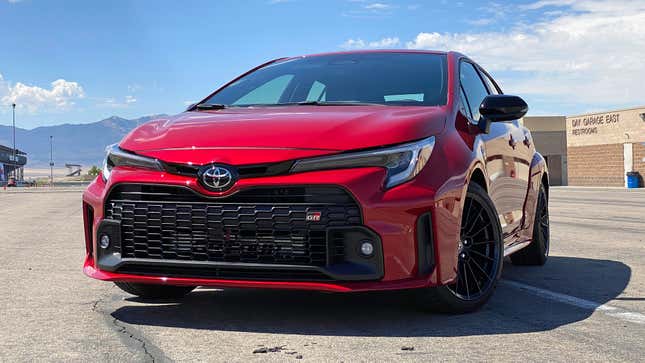
Just two weeks ago, I drove the Volkswagen Golf R. The timing was purposeful, because I knew I’d be checking out the GR Corolla soon after, and the two cars are very similar in specs and proportions. As it turns out, they’re completely different in spirit.
The Golf R certainly feels a smidge faster, especially on sprints from a standstill, thanks to the dual-clutch automatic transmission. Volkswagen quotes a 0-60 time that beats Toyota’s by only a few tenths — 4.7 seconds for the Golf R versus 5 flat for the GR Corolla, though some outlets have found the Golf to be even quicker than that.
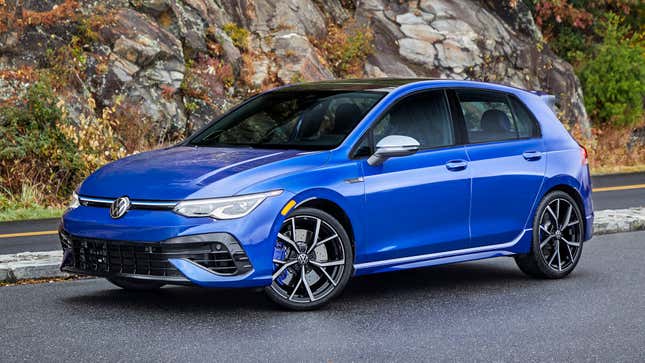
As long as we’re here, I’ll relay another detail that may be of significance to cross-shoppers: fuel economy. Toyota rates the GR Corolla at 21 MPG city, 28 highway and 24 combined. On paper, the Golf R bests those numbers by one or two MPG depending on the transmission. I didn’t drive the Corolla on public roads at all — Toyota’s media event was strictly on track — but I lived with the Golf R in the suburbs, mountains and on the highway, and I still averaged an impressive 31 MPG. With both of these cars requiring 91 octane or better, the Corolla’s apparent thirstiness is a little concerning.
But the Golf R also feels like it’s trying to keep a part of itself from you. Vibrations are all a little too deadened, and the powertrain’s character — profoundly capable though it is — doesn’t shine through as readily amid the countless technological efforts to make everything feel smooth and immediate. It has the soul of a grand tourer, not a gravel-spewing hellion.
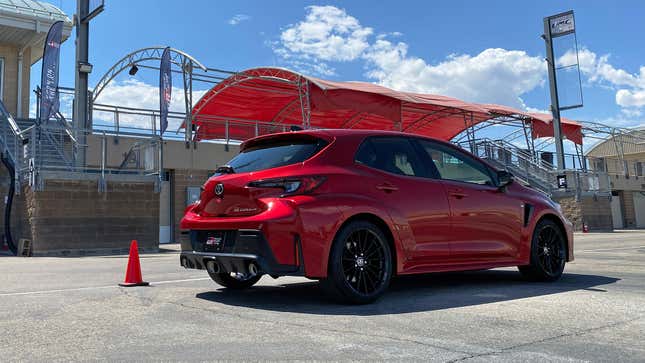
The GR Corolla strikes as harsher and more honest. Lacking luxuries like the Golf R’s adaptive damping, it doesn’t slip as effortlessly into everyday driving. But it also starts at $8,000 less than the $45,000 Volkswagen. Eventually, the GR Corolla will also have to answer to Honda’s more powerful but strictly front-wheel drive 2023 Civic Type R, whose pricing is still a mystery.
It’s funny. Had Toyota given us this car five years ago, we’d be sizing it up against the Focus RS, Veloster N and WRX STI. In fact, ignoring the obvious differences in drivetrain, this Corolla reminds me of my discontinued five-door, the Fiesta ST. An ordinary compact with an extraordinary drivetrain; an accessible path to everyday joy in a package you can actually use every day — so long as Toyota’s dealer network doesn’t render MSRP a pipe dream. Isn’t that exactly what brings us to gather at the altar of the hot hatch?